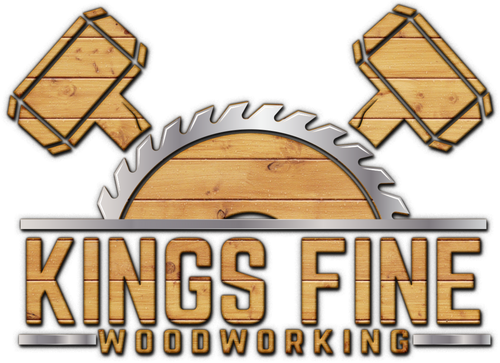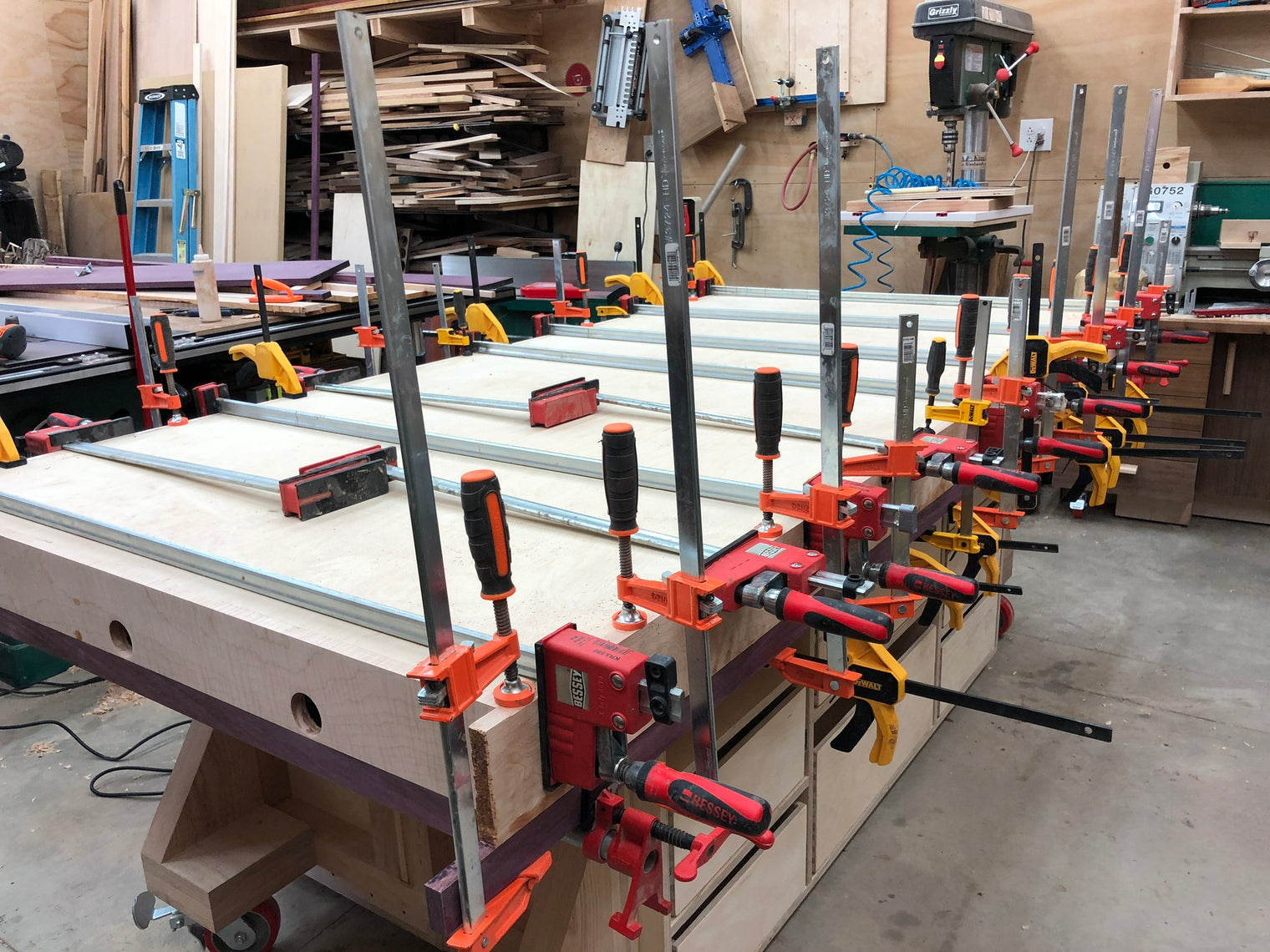
Many people are worried about over-clamping. I say that’s absolutely not a concern. Here’s why:
Consider this. I have a cutting board that is 12” x 18” and 2” thick. It consists of many boards glued together to make the whole thing
Let’s take two of those interior boards. They are 2” tall by 18” long. And I have to glue them together.
2x18 = 36 square inches of glue surface.
It’s a hardwood. So Titebond says I can use 250 pounds per square inch in clamping force.

36 square inches x 250 pounds per square inch = 9000 pounds of clamping force recommended.
Who would have thought that two little boards should be clamped together with 9000 pounds of force??!
Well, the scientists & engineers at Franklin Adhesives (makers of Titebond), who have been studying the chemical & physical properties of PVAs & have been extensively researching how to achieve the very best bond for the last three quarters of a century think that it’s necessary.

So I generally defer to them on this aspect. My take is that if a manufacturer of a product employs research scientists that determine the best way to use their product, then that truly is the best way.
Now let’s get practical. This glue up is only 18” long. How do I get 9000 pounds of force on it?

It looks like I can get 7-8 pipe clamps on it. But the truth is, that would just barely fit.
In all likelihood, we aren’t going to try clamping to such extremes. But I did this exercise to prove a point. It’s exceedingly hard to over-clamp. Mostly because we’d have to fill every square inch with clamps.
So my advice is to do this:
Use as many clamps as will comfortably fit. And secure them tightly. Almost certainly you will get a great joint. (Probably not the strongest possible, but that’s ok) And, you will have no fear of over-clamping.
If you are curious as to the science behind why a very tightly clamped joint is so strong, I’ll tell you. PVA adhesives have great adhesive strength (meaning they stick very strongly to other things), but they have a very low cohesive strength (meaning they stick very poorly to themselves).
The reason high pressure is great is that it forces the bond to have a very thin layer of adhesive inside. So that virtually all of the strength of the joint is adhesive strength. If the joint has a thick layer of glue inside, then we are also relying on cohesive strength. Or the ability of the glue to stick to itself. (Which we know is poor).
This is also why PVA glues are considered poor at gap filling. Inside of a gap is a large amount of glue that not only must stick to the wood on either side of the gap, but it must stick to itself over a considerable thickness. Which it does poorly due to its low cohesive strength.
Epoxy, on the other hand, is a great gap filling glue. It has high adhesive AND high cohesive strength.
Titebond official recommendations:
http://www.titebond.com/product/glues/e8d40b45-0ab3-49f7-8a9c-b53970f736af
Fine Woodworking article:
“Most woodworkers are underclamping their joints during glue up.”
https://www.finewoodworking.com/2010/05/11/how-to-glue-up-joints-the-right-number-of-clamps


Can Glue Joints Be Clamped Too Tight?
Comments (23)
Dear Mr king I love wood Working projects I want to build a Barn style Shed 12×12 with 9 feet tall walls double doors 7 feet tall. I don’t know if true I was told I need 22.5 degrees on the trusses. I want to know if can get me plans for that shed thanks 🙏
Hello James:
I have had few problems with glue ups but buckling has always been my biggest concern. I was worried about starving the joint of a necessary amount of glue especially on table tops and cutting boards. I feel better now after reading your article. I’ve been woodworking for over 12 years now and I truly enjoy your videos. By the way my wife and daughters love the jewelry boxes that I made for them from your video about 6 months ago. I recently purchased your adarondak chair plans and templates. Keep up the good work.
Chuck Ford
Houston, Texas
Hello James:
I have had few problems with glue ups but buckling has always been my biggest concern. I was worried about starving the joint of a necessary amount of glue especially on table tops and cutting boards. I feel better now after reading your article. I’ve been woodworking for over 12 years now and I truly enjoy your videos. By the way my wife and daughters love the jewelry boxes that I made for them from your video about 6 months ago. I recently purchased your adarondak chair plans and templates. Keep up the good work.
Chuck Ford
Houston, Texas
I agree the glue joint is strong. The over-clamping issue I thought was if you tighten the clamps too tight in a glue up you can force the boards to buckle and be high in the center. Think of a cutting board with many 1 1/2 wide boards glued length wise. I was told just tighten the clamp enough to get squeeze-out. I was told this would happen even on jointed edges that check at 90 degrees. I for sure don’t understand what happens to cause the buckle if everything is flat 90 to start. If this is wrong please discuss.
Thank you for taking the time to drop this knowledge in one easy to follow article. As a “glue master” recipient it’s awesome to factually understand the reasoning behind gluing and clamping methods. Thank you.
Unless I missed it I didn’t see any discussion about buckling of thinner boards and force superposition, i.e., the clampling force is not just perpendicular from the face of the clamp but spreads between clamps. In order to model this properly you’d have to consider the Young’s Modulus and Poisson’s Ratio of the assemblage of mating woods.
Hi . King,
I really enjoy & appreciate all your pointed out advise in your all youtube videos.
Many thanks .
Esam Abudraa.
Sir you are the first person showing how make something out of wood that does need the cost of very expensive tools. Also I was surprised that you did not glue up any joints. I liked that. Will watch more of you videos. Ill make the chairs I have just received the plans for thanks. Cheers Pete UK.
Dear M. King, In 1988 I renovated a 200 y.o. house replacing the softwood with hardwood doors and windows. A local firm did this custom job. I was astounded to find that they were using massive hydraulic presses to complete all the joints in the mahogany. The one thing that was tight was the frame inside the bricks and mortar aparture! Zero foam needed.
Mr. King,
You are a consumate wood craftsman, I really enjoy your videos, they are truly well done. Your website has great
i appreciate your informative videos and have a high regard for you. thanks so much, ronald
I find missing in some of this discussion the importance of true 90 degree edges being glued. It has been my experience that compensating for a degree of inaccuracy in this prep by lots of pressure is a faulty approach. It takes not lots of pressure to squeeze the glue out of a properly prepared joint.
I love watching your U-Tube videos. they are so informative and detailed. I’m pretty new to woodworking but really enjoy making just about anything. I have mostly stuck to simple shop jigs and am trying to obtain some of the more usefull tools. I have noticed how much you use your jointer, guess that will have to go to the top of my want list. Thank you for making the videos, they are so helpful.
The glue joint needs to be “strong enough for the intended purpose”. Building a jack stand for your F350 dual wheel pickup has different requirements than a kitchen cutting board. Unless the centerline of the clamping force is perfectly aligned with the centerline of the boards being glued, “excess” clamping force will cause the glued up assembly to not be flat.
Greetings James. I was fortunate enough to find your website while googling “wooden threads” and have never looked back. The information you provide and the information available from the other websites to which I was introduced by your website is limitless. It is like drinking from a fire hose !
I am old enough to remember when glues were not what they are today. Those of my vintage sometimes refer to “glue-starved joints.” I spent many years believing in glue-starved joints absolutely …. not so much any more. If you Google “glue-starved joints”, you will find a disparity of opinions, beliefs, some better than others.
Mr. King, Love your videos have learned quite a bit. Retired home
remodeler just recently started my home shop and building finer projects. One problem since following you I am using a lot more glue than before. Thanks for sharing your knowledge.
James,
I enjoy your YouTube videos. You explain what your doing well when building jigs and things, as well as in your blog. Thank you.
Like your videos and teaching your daughters about woodworking I wish I had some one to teach me great job I’m learning every time I watch your videos I wish more girls and boys would learn the trade
Good to know. Thanks!
Can’t find the plans for the Fibonacci tool on your video. Can you help?
Good article. I watched your youtube mini sled and downloaded the push stick plans. Keep up the good work.
Great article on clamping. Very well written!
Love the answer here! It is hard to explain why a proper, glued joint is actually stronger the wood around it, but I think you did. I love your videos and you sharing your knowledge and skills for the betterment of others. God bless you and your family!